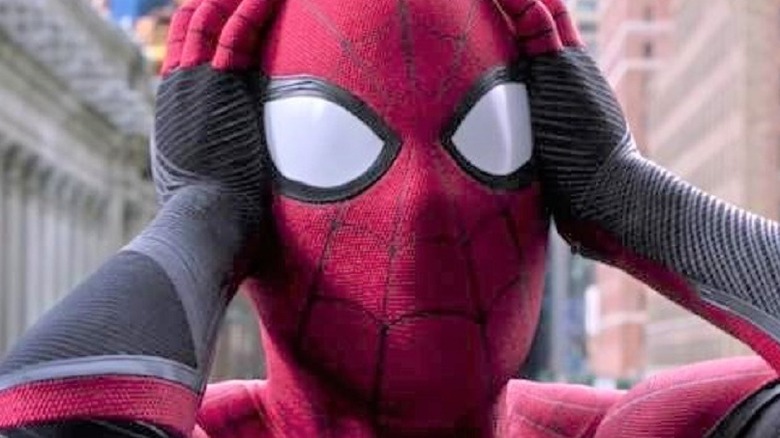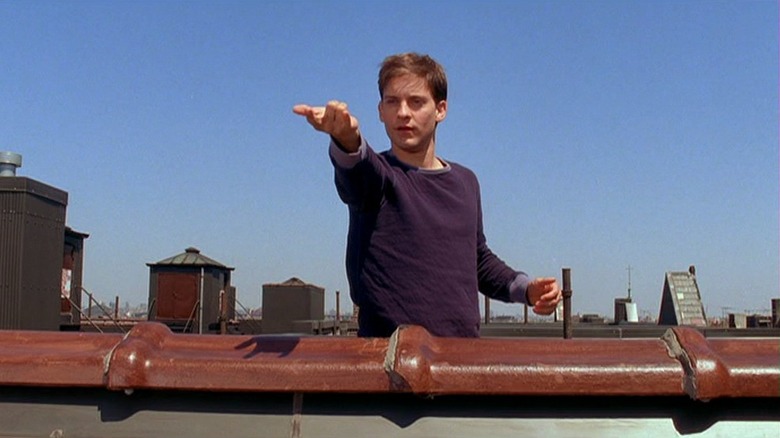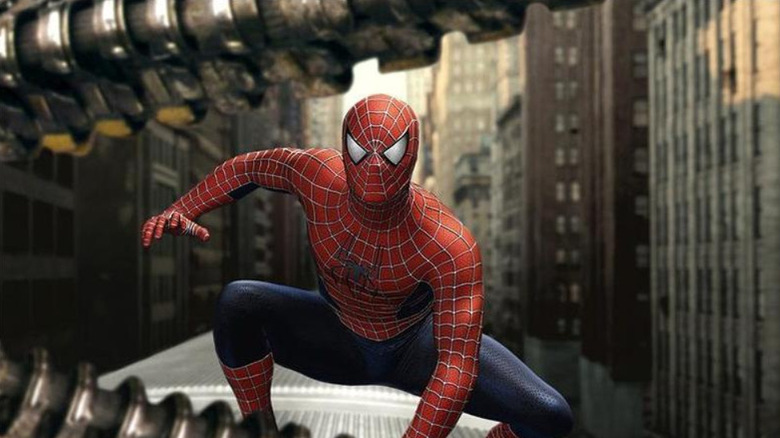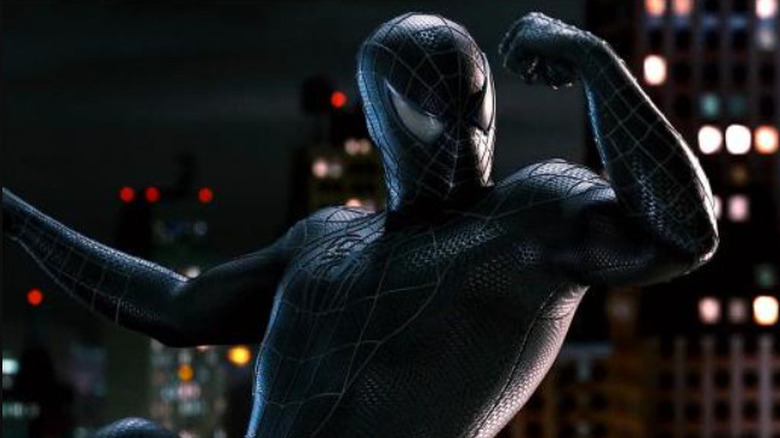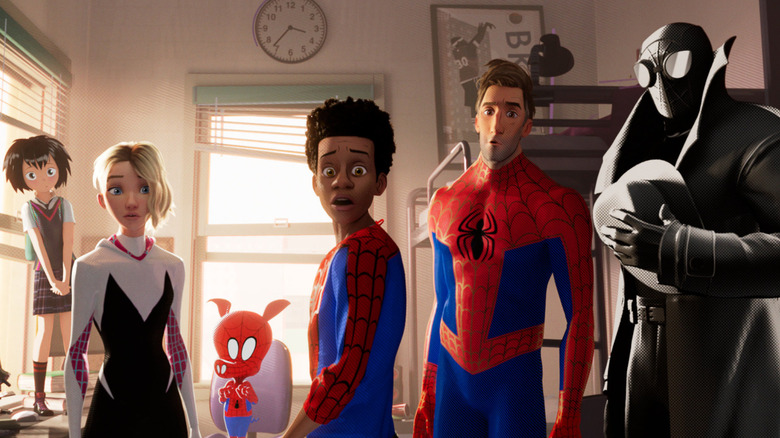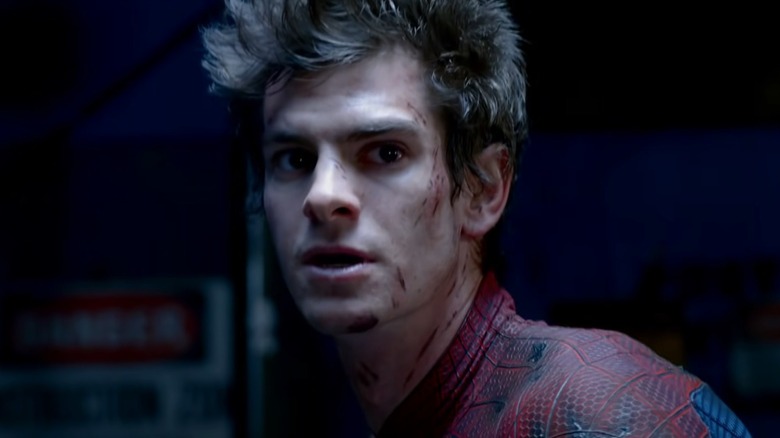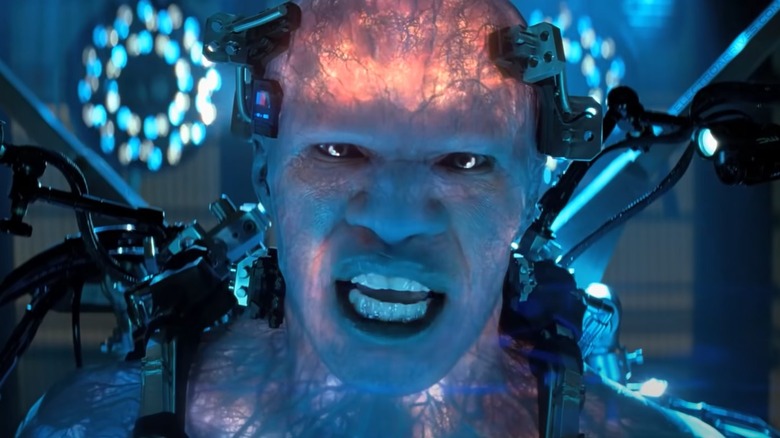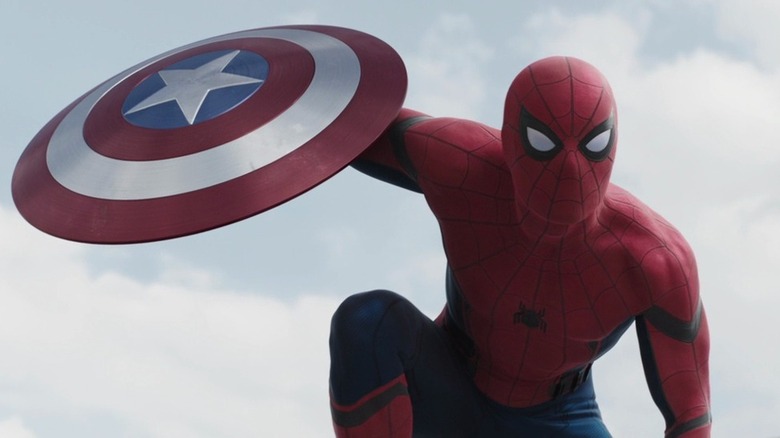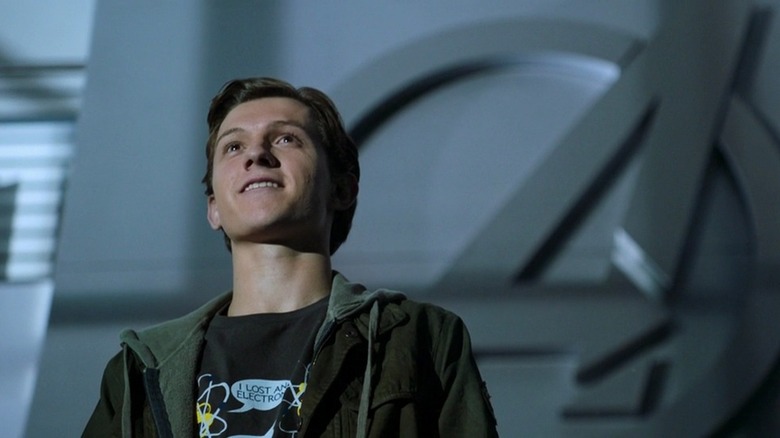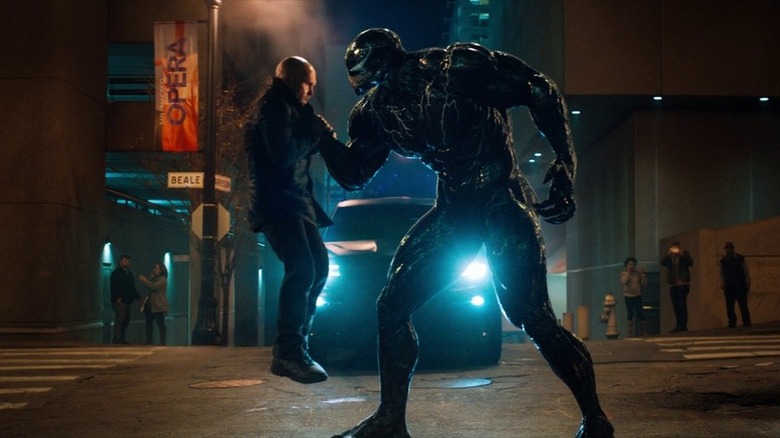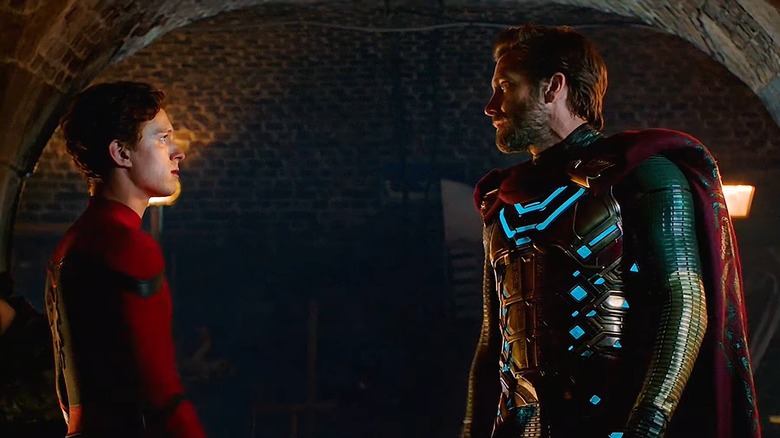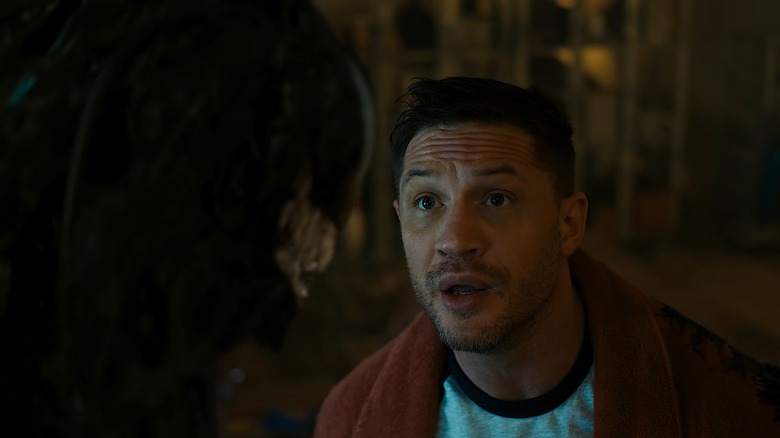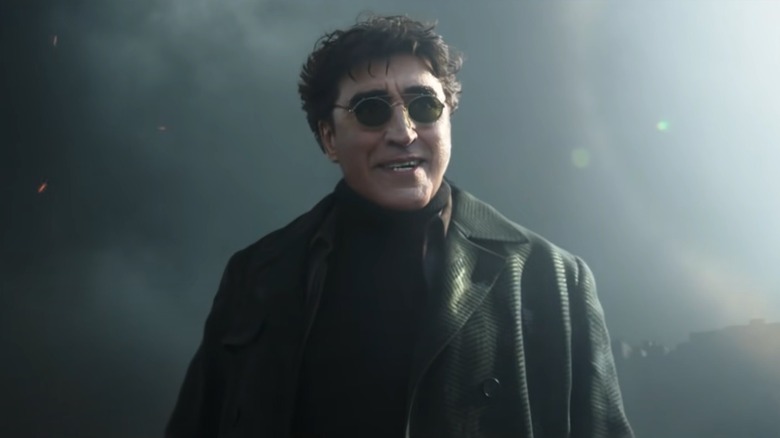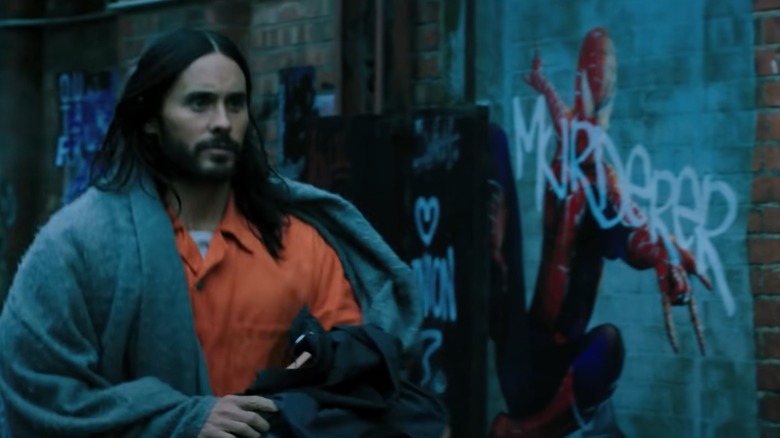How To Watch Every Spider-Man Movie In Order
These are exciting times for Spider-Man fans. "No Way Home" is opening up the MCU to the multiverse, heralding the arrival of characters from previous live-action "Spider-Man" movies, like Alfred Molina's Doctor Octopus from the Sam Raimi films.
The excitement doesn't end there. After years of being kept apart, the recently released "Venom: Let There Be Carnage" finally confirmed that Tom Hardy's Eddie Brock and Venom have entered the same reality as Tom Holland's Peter Parker, and the two mortal enemies from the comics are set on an epic collision course that will shake up superhero movies in a manner never seen before.
With so many exciting updates to Spidey's live-action mythology, now is a good time to look back on the webbed wall-crawler's history on the big screen, all of which is soon going to be tied up into one massive, universe-breaching reality. Here's the order in which you should watch all previous live-action "Spider-Man" movies (and one very important animated film) to prepare yourself for the multiverse-spanning madness of what comes after "Spider-Man: No Way Home."
Warning — there are spoilers ahead.
Spider-Man
While it can be argued with good reason that early movies like 1998's "Blade" and 2000's "X-Men" were responsible for kickstarting the interest in Marvel live-action movies, it's filmmaker Sam Raimi's 2002 take on "Spider-Man" that in many ways serves as the blueprint for the modern Marvel Cinematic Universe. Unabashedly colorful and gloriously pulpy, "Spider-Man" heralded the arrival of a new type of superhero movie where the scope and imagination of Marvel Comics could finally be translated onto the big screen with the help of modern special effects.
Aside from its importance for the superhero movie genre, "Spider-Man" is also generally agreed to be "the" definitive origin story for everyone's favorite webbed hero. Tobey Maguire ably portrays high school nerd Peter Parker, who hangs out with his best friend, Harry Osborn (James Franco), and has modest suburban dreams like owning a car and asking out his long-time crush, Mary Jane Watson (Kirsten Dunst).
Peter's life is turned upside down when he is bitten by a radioactive spider that grants him superpowers, and a personal tragedy convinces Peter to use his powers to help people as Spider-Man. But matters are complicated when Peter's sense of duty puts him in the crosshairs of Norman Osborn/Green Goblin (Willem Dafoe in a delightfully scene-chewing performance). Exciting, funny, and at times genuinely heart-warming, "Spider-Man" was the perfect introduction for one of the most famously grounded, everyman superheroes in comic book history.
Spider-Man 2
As good as the first "Spider-Man" was, you could tell the movie was still trying to find itself in terms of its overall tone and narrative aspirations. With its sequel, "Spider-Man 2," the makers of the franchise finally found that near-perfect combination of story, themes, and cast of characters to create one of the greatest superhero movies of all time.
After a few years of shouldering the responsibility of being Spider-Man, Peter Parker is starting to feel fed up with being the guy who must constantly sacrifice his personal time and his relationships with his loved ones in order to anonymously save the day. Following a bunch of problems hitting him all at once, including his powers fading away, Peter has finally had enough, and he vows he's done with being Spider-Man.
Unfortunately, that's when the city chooses to welcome its newest supervillain, Alfred Molina's fan-favorite take on Doctor Otto Octavius, aka Doc Ock. When Mary Jane's life is threatened, Peter has no choice but to once again don the mask and swing into action. Thanks to some truly breath-taking action sequences involving a speeding train and the genuinely moving relationship between Peter and Octavius, "Spider-Man 2" set the bar against which all future "Spider-Man" movies would be measured.
Spider-Man 3
It's ironic that immediately after making a standout film like "Spider-Man 2," filmmaker Sam Raimi returned to the franchise with what's generally seen as one of the weakest "Spider-Man" movies of all time, 2007's "Spider-Man 3." With scenes including an emo Peter Parker thrusting his hips at an imaginary crowd, a distinctly scrawny take on Venom, and a multitude of subplots more unnecessary than Doc Ock's human arms, it's easy to see where all the criticism comes from.
Still, "Spider-Man 3" is important if you're looking at the history of Spidey on the big screen. The movie does away with many of the secrets that defined the previous two movies in the franchise. Mary Jane knows Peter's secret identity, as does his best friend turned enemy, Harry. It's these two changed relationships that provide the main emotional heft of Peter's journey through the movie.
But there's also danger to be faced in the form of a strange alien symbiote that attaches itself to Spider-Man and makes him more powerful and more aggressive. The movie also retcons the identity of Uncle Ben's killer, introducing us to a mugger who's now calling himself the Sandman. It's a lot of story to get through, and directing such an unwieldy film made Raimi determined to make the next one the best entry yet. But unfortunately, that movie never ended up happening.
Spider-Man: Into the Spider-Verse
At this point, before we get into the reboots and the retellings and the false starts that the next few years of "Spider-Man" movies would become mired in, it's useful to look into an animated movie that came years later in 2018, "Spider-Man: Into the Spider-Verse," which turned out to be an important portent of things to come.
"Into the Spider-Verse" tells the story of regular teen Miles Morales, who lives in the same city as Spider-Man. A series of events grants Miles powers similar to Spidey while also killing his city's webbed superhero and opening up a gateway to other dimensions, each with its own version of Spider-Man. This allows Miles to meet and train under an older Peter Parker who's hinted to be an aged version of the character seen in Sam Raimi's films.
The plot introduces viewers to the concept of the multiverse, where infinite versions of Spider-Man exist in separate realities that can interact under the right circumstances. After watching "Spider-Man: Into the Spider-Verse," viewers can be primed to dive into the other live-action "Spider-Man" movies starring new actors playing different versions of the most iconic Spider-Man of all, Peter Parker, from different realities within the overarching multiverse.
The Amazing Spider-Man
Now that we know about the multiverse, it's time to dive into one of the universes explored in filmmaker Marc Webb's 2012 feature "The Amazing Spider-Man." This time around, Andrew Garfield plays the titular role of Peter Parker/Spider-Man, and Mary Jane is replaced by Gwen Stacy (Emma Stone).
With Sam Raimi's films still fresh in the minds of audiences, Webb took some daring steps to make his "Spider-Man" movie different from what had come before. For example, Garfield's Peter is a lot edgier and darker than Tobey Maguire's version of the character. While this throws some fans off, the fact is Garfield's take on Peter is a lot more accurate to the original comics, where the character was depicted as a somewhat cynical and smart-mouthed teen who thought beating up the Fantastic Four was a good way to join their team.
Unfortunately while Garfield gives everything he has to the lead role and has sparkling chemistry with Stone, the film is bogged down by an uninspired plotline and a muddled third act involving the main villain, the Lizard (Rhys Ifans), wanting to turning the entire city into lizard people or something.
The Amazing Spider-Man 2
You'd think Sony would've learned its lesson about the dangers of stuffing too many villains and plotlines into a single movie after the negative reception to "Spider-Man 3." But then came 2014's "The Amazing Spider-Man 2," and it was pretty much a retread of the same issues.
The film sees most of the original cast from the first movie returning. Peter Parker is now in a relationship with Gwen Stacy. He also apparently has a best friend in Harry Osborn (Dane DeHaan), who needs Spider-Man's blood to cure his deadly illness. Why doesn't Peter just donate some blood to save his best friend? Because that would end the movie too quickly, and Harry would have no impetus to turn into the Green Goblin.
There's also another main villain in the movie in the form of Jamie Foxx's Electro. The actor does what he can with the role — one he'd reprise later on in the franchise — but its a thankless task when the writing for the character is so one-note. It's telling that the most memorable scene in the entire movie isn't one involving Spidey battling his villains but the death of Gwen Stacy.
Captain America: Civil War
Enough of Spider-Man saving the day on his own. We now move to another corner of the multiverse known as the MCU. For years, Marvel Studios was unable to use Spider-Man because Sony owned the rights to the character. But thanks to some judicious behind-the-scenes negotiations, fans lost their minds when the trailer for "Captain America: Civil War" announced the arrival of the MCU's version of the webbed wall-crawler.
In this reality, Peter Parker is played by Tom Holland as a fresh-faced high schooler who's already been putting in time as a local superhero. Things get kicked into high gear after it's revealed that Tony Stark (Robert Downey Jr.) has been keeping an eye on this up-and-coming crime-fighter, and he invites Peter to help him stop Captain America's (Chris Evans) team of renegade Avengers.
There's something irresistibly winsome about Holland's take on a young and nervous Spider-Man meeting these legends of the MCU for the first time. While the movie doesn't have a big role for the character, this new Spider-Man was an instant hit with audiences and proved there was a place in the big leagues for the friendly neighborhood wall-crawler.
Spider-Man: Homecoming
Now comes Spider-Man's first full-fledged adventure in the MCU. Set shortly after the events of "Captain America: Civil War," Peter Parker's life has forever been changed after his secret mission alongside Iron Man and his allies. Peter considers himself an honorary Avenger, and he's eager to go on more adventures with Iron Man's crew, finding it difficult to go back to being a local do-gooder.
Still, he has no choice but to stay grounded for now and get used to the new suit Tony Stark has set Peter up with. There are also high school problems to deal with, as well as the arrival of new supervillain Adrian Toomes, aka the Vulture (Michael Keaton). Toomes was an ordinary blue-collar worker when he found his work being overtaken by a superhero-run agency. He then decided that the only way to survive in this new world was by getting super abilities himself.
"Spider-Man: Homecoming" is one of the better entries in the hero's live-action filmography while never quite managing to reach the heights of the best of the best. There is also some criticism from fans regarding Peter's overreliance on Tony Stark's advice and technological gifts. Still, the movie is a solid entry in Spidey's journey within the larger MCU.
Infinity War and Endgame
The next leg of Spider-Man's journey within the MCU takes place during the most cataclysmic event this reality has ever experienced. In "Infinity War," Thanos, aka the Mad Titan (Josh Brolin), has embarked on a quest to gather the six Infinity Stones, which would allow him to wipe out half of all life in the universe. Two of those stones are on Earth, meaning otherworldly forces soon overrun the planet and every available superhero must lend a hand.
Peter acquits himself well in the proceedings, especially after getting a major suit upgrade from Tony Stark. Still, the character is one of the 50% of all living things to get dusted after Thanos manages to gather the gems and snap his fingers. Peter's death sequence gives us one of the most emotional scenes in the MCU and in "Spider-Man" movies in general (and the source of countless internet memes and reaction videos).
Five years pass before the remaining Avengers are able to undo the damage wrought by Thanos and bring everyone back from the dead in "Endgame." Spider-Man is one of the characters who gets to make a triumphant comeback during the final battle against Thanos. But even though the Avengers win the day, the repercussions of the "Infinity War" would be felt long afterwards on a personal level, as we get to see in the next solo "Spider-Man" movie.
Venom
We now move to a distant, seemingly unrelated part of the multiverse where one of Spider-Man's most popular villains is preparing to make his own debut as a troubled anti-hero. Since Sony had the rights to a bunch of Spider-Man-related characters from the comics, they decided to take a shot at creating their own cinematic universe, and the first installment in the planned series was 2018's "Venom."
Starring Tom Hardy in the lead as journalist Eddie Brock, the movie takes several liberties from the source material to divorce Venom's origins from "Spider-Man" mythology. In the movie, an exploratory space vessel returns to Earth harboring a number of alien creatures called "symbiotes." While investigating the shady dealings of the company that's studying the symbiotes, Eddie unwittingly bonds with one that calls itself "Venom."
Thanks to its new connection to the symbiote, Eddie comes to possess monstrous superpowers and a new alien voice in his head that begs him to let it eat people. The movie works as a strange "buddy cop" action comedy thanks mostly to Hardy's central performance, even if the overall story and the rest of the cast leave much to be desired.
Spider-Man: Far From Home
We're jumping back into the main MCU real quick to see what Tom Holland's Spider-Man is up to. Some time has passed since the Avengers succeeded in reversing the effects of Thanos' snap. Half the world's population has returned to the land of the living, including Peter Parker, and they're still trying to grapple with the effects of Thanos' machinations and what it took to stop the Mad Titan.
For Peter, the biggest loss comes with the death of his mentor, Tony Stark. But just because Stark is gone doesn't mean he's done with Peter. It's soon revealed that Stark has left Peter control over some pretty significant parts of his technological empire, including an army of drones that quite frankly have no business being controlled by a high schooler, even if he is an Avenger.
Peter also meets a man who calls himself Mysterio, who also claims to belong to a separate universe before being accidentally transported to this one. This story later turns out to be false (what else can you expect from a guy named Mysterio?), but it's the first time that this version of Peter comes into contact with the idea of the multiverse — that there are worlds beyond his own universe that might harbor other heroes and villains.
Venom: Let There Be Carnage
We're jumping one final time from one unconnected part of the multiverse to another, from the MCU to Sony's Spider-Man Universe. After the breakout success of 2018's "Venom," a sequel was pretty much guaranteed. In "Venom: Let There Be Carnage," Eddie Brock has been living with the alien symbiote in his head for some time now, and the two have come to some sort of an understanding.
That's when sociopathic serial killer Cletus Kasady (Woody Harrelson) gets thrown into the mix, after coming into contact with an offspring of the "Venom" symbiote. Imbued with his very own symbiote, Kasady transforms into the supervillain Carnage, a creature that even Venom fears. Eddie and Venom must now work together to grapple with a host of new symbiote-related issues while still trying to find their own common ground.
Even though the film is mostly self-contained, the post-credits scene changes everything for its own franchise, as well as the MCU. Some sort of magic trickery occurs that transports Venom into the same reality as Tom Holland's Spider-Man, and it's strongly implied that the two iconic enemies from the comics are now set for an epic showdown that will shake up the entire multiverse.
Spider-Man: No Way Home
We now come to the movie that's perhaps the most important with regards to setting up a multiverse of "Spider-Man"-related chicanery. After years of teasing the possibility of other universes with their own versions of the webbed wall-crawler and his supporting cast, Tom Holland's Spidey finally makes his journey into the different worlds thanks to some interdimensional magic, courtesy of Doctor Strange (Benedict Cumberbatch).
While the main plot of the movie is yet to be revealed, we know from the trailers and promotional materials that Holland's Spider-Man will come into contact with villains from previous live-action "Spider-Man" films, including Alfred Molina's Doctor Octopus and Jamie Foxx's Electro. Tom Hardy's Venom might also be in the mix thanks to the post-credits scene in "Venom: Let There Be Carnage," although whether Hardy will actually be making an appearance in "Spider-Man: No Way Home" is still not confirmed.
The biggest question on everyone's minds is whether Holland's Spider-Man will be meeting the men who laid the groundwork before him — Tobey Maguire's OG Spidey and Andrew Garfield's edgy reinvention of the character. Whatever ends up happening, it's safe to say the days of live-action Spider-Man being a strictly local neighborhood hero are now over.
Morbius
We finally arrive at the "wild card" of the live-action "Spider-Man"-related movies that have been churned out with such regularity for the last two decades. On the surface, "Morbius" is like 2018's "Venom," in that it's being billed as a stand-alone movie that will attempt to take a popular villain from "Spider-Man" comics — Michael Morbius (Jared Leto), the Living Vampire — and turn him into an anti-hero capable of headlining his own franchise.
But the trailer for "Morbius" has hinted at many significant connections to the larger world of the live-action "Spider-Man" movies. In one shot, we see graffiti of Tobey Maguire's Spider-Man in the background. We also see Morbius interacting with Michael Keaton's MCU character, Adrian Toomes. It seems clear that "Morbius" is set firmly within the larger Marvel multiverse instead of being its own thing.
Recently, while talking about the extent of his involvement in the post-credits scene for "Venom: Let There Be Carnage," MCU showrunner Kevin Feige told The Hollywood Reporter, "There was a lot of coordination [between Marvel Studios and Sony] — and if you don't know all the coordination yet, I'm not going to be the one to tell you." It seems likely that we'll be seeing the results of that coordination in "Morbius" next as the new Spider-Man cinematic multiverse continues to gather steam.
